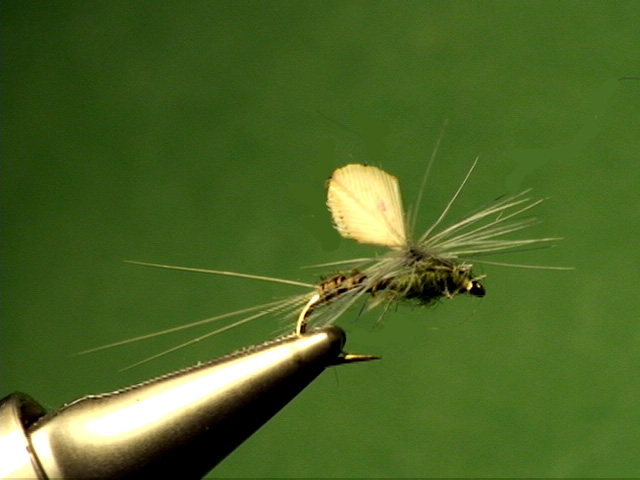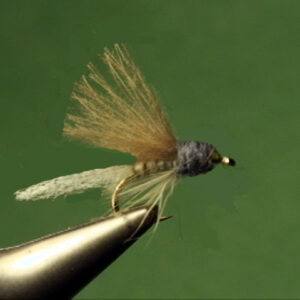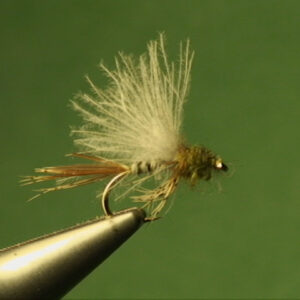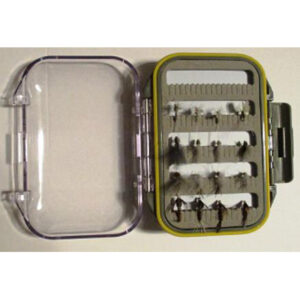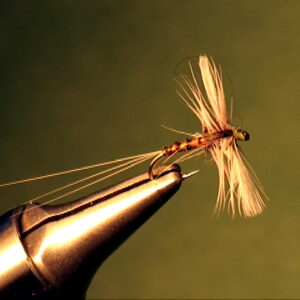Hook Size: 14/16/18/20
The Perfect Fly Blue Wing Olive Dun is an excellent imitation of the adult stage of life of the mayfly. It imitates the mayfly as it drifts or floats on the surface, drying it wet wings enough to fly off the water onto the banks, bushes or trees where it will eventually change into the spinner stage of life. It even imitates the dun down to two or three tails and it two upright wings. It is fished on the surface as a dry fly. It should be treated with floatant.
Blue-winged Olives, which are usually baetis species duns, have two tails with a very tiny
hind wing. Some species do not have a hind wing at all, but this minor difference is not
important at all and we point it out, just for identification purposes. Like the name implies,
the bodies of most duns are a green or emerald – olive color with gray highlights and the
wings are a shade of gray.
If the water and air is cold, the Blue-winged Olive duns will ride the water for a relatively
long time. Often the problem with early and late season hatches is that the trout are also
cold and as a result, are not very active. It’s much easier for them to take the nymphs
and emerging nymphs in the surface skim than it is the duns. This most often happens in
the early season. Later on in the season when the water is warmer, they tend to take the
duns much better. During the Fall hatch, unless the weather has turned extremely cold,
the dun imitations usually work great.
The Blue-winged Olive hatches can be so prolific that the water is covered with the little
Blue-winged Olives. Getting the trout to take your imitation over the real ones can be a
challenge. The best procedure under these conditions is to select one fish and present
your dun imitation to it in a timely manner.
If conditions are right, the Blue-winged Olive dun pattern, or dry fly, can be an exciting
way to fish during the hatch. If you find that the trout are not responding to your dun
pattern very well and you are not determined to fish the dry fly under any conditions, you
should change back to an emerger pattern. It shouldn’t take long to determine this during
a good Blue-winged Olive hatch. The trout will usually line up in the current seams when
they are feeding on the duns. You should concentrate on drifting your dun pattern
drag-free in the current seams. This is not exactly easy to do under some circumstances.
This is especially true in smooth or slick water. The smooth, slick water found in some
streams, can consist of strong, conflicting currents. This type of water can make it very
difficult to get a drag fee drift.
If you make a few bad cast over a trout (sometimes just one bad cast) then you may have
to move to another area. Generally speaking, long light leaders and tippets are
necessary in the smooth water. Nine to twelve foot leaders and 6X tippets are not
uncommon under these conditions. In pocket water, you can get by with heavier leaders
and tippets, shorter cast and maybe even a few mistakes.
Presentation:
In some situations there may be a lot of flies on the water, making your dry fly imitation
just another one of many duns drying their wings in preparation to fly away. In this case,
you are much better off finding one feeding trout and concentrating on catching it, than
schools or pods of feeding trout. Everything relative to the emerger presentation applies
to the dun imitation, except it is fished dry on the surface. This is very demanding trout
fishing in many smooth water situations. Even in pocket water, the dun will float down the
current seams adjacent to the slow water areas where they hatch. Sometimes they are
trapped in shallow, calm areas within the pockets and calm areas of water along the
banks of the stream. In either case, this requires a longer and lighter than normal
leader.as well as a good presentation.
Copyright 2013 James Marsh
